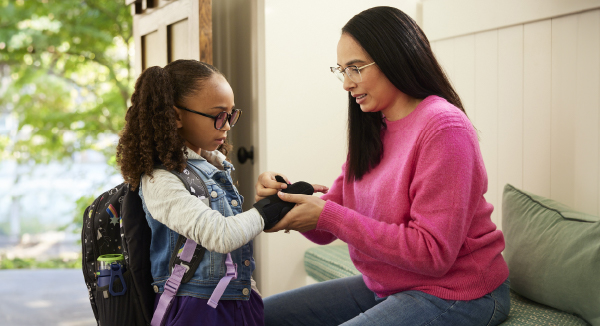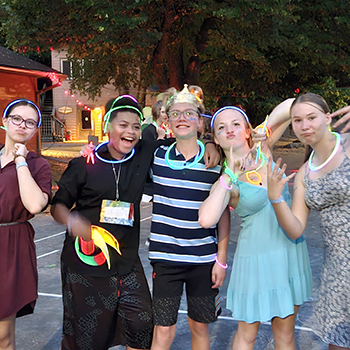Raising Awareness in July for Juvenile Arthritis Month
July is the time to elevate awareness about juvenile arthritis and help make a difference in the lives of the hundreds of thousands of kids in the U.S. who live with it.
By Anthony Williams and Bryan D. Vargo
 July is Juvenile Arthritis (JA) Awareness Month and a time to elevate awareness about juvenile arthritis (JA) and other childhood rheumatic diseases. Together with the JA community and partners, the Arthritis Foundation shines an even brighter light on the challenges of JA and the hundreds of thousands of kids in the U.S. who live with it.
July is Juvenile Arthritis (JA) Awareness Month and a time to elevate awareness about juvenile arthritis (JA) and other childhood rheumatic diseases. Together with the JA community and partners, the Arthritis Foundation shines an even brighter light on the challenges of JA and the hundreds of thousands of kids in the U.S. who live with it.
The goal of Juvenile Arthritis Awareness Month is to spread the word that kids get arthritis, too. Most people are surprised to learn that arthritis isn’t “just an old person’s disease” and can affect children as young as just a few months old.
The Arthritis Foundation and its partners lead advocacy and research to improve access to care and provide resources that support JA families. Foundation partners include the Centers for Disease Control and Prevention (CDC), the National Institutes of Health (NIH), the Childhood Arthritis Rheumatology Research Alliance (CARRA), Alpha Omicron Pi (AOII) and countless other organizations and individuals.
 July is Juvenile Arthritis (JA) Awareness Month and a time to elevate awareness about juvenile arthritis (JA) and other childhood rheumatic diseases. Together with the JA community and partners, the Arthritis Foundation shines an even brighter light on the challenges of JA and the hundreds of thousands of kids in the U.S. who live with it.
July is Juvenile Arthritis (JA) Awareness Month and a time to elevate awareness about juvenile arthritis (JA) and other childhood rheumatic diseases. Together with the JA community and partners, the Arthritis Foundation shines an even brighter light on the challenges of JA and the hundreds of thousands of kids in the U.S. who live with it.The goal of Juvenile Arthritis Awareness Month is to spread the word that kids get arthritis, too. Most people are surprised to learn that arthritis isn’t “just an old person’s disease” and can affect children as young as just a few months old.
The Arthritis Foundation and its partners lead advocacy and research to improve access to care and provide resources that support JA families. Foundation partners include the Centers for Disease Control and Prevention (CDC), the National Institutes of Health (NIH), the Childhood Arthritis Rheumatology Research Alliance (CARRA), Alpha Omicron Pi (AOII) and countless other organizations and individuals.
While there is no cure for juvenile arthritis, the work of the Arthritis Foundation and its research partners have expanded the ways to manage and treat it.
Source: JA Insights Report
To better understand arthritis in children, it’s important to note that juvenile arthritis is an umbrella term that refers to pediatric rheumatic diseases — including juvenile idiopathic arthritis and other musculoskeletal conditions — that can develop in children ages 16 and younger.
Juvenile idiopathic arthritis (JIA) is the most common type of arthritis in children. There are several different subtypes of JIA: oligoarticular JIA, polyarticular JIA, systemic JIA, enthesitis-related JIA, juvenile psoriatic arthritis and undifferentiated JIA. While each subtype shares many of the same symptoms — namely pain, inflammation and fatigue — each subtype is distinct and also has its own special concerns, symptoms and treatments.
Moreover, JA and related conditions are often compounded by other illnesses, such as uveitis (inflammation of the eye), skin ailments and other comorbidities that affect the heart, lungs and other vital organs. Juvenile arthritis can also have a profound effect on a child’s mental and emotional well-being. In fact, 65% of kids with arthritis have moderate to severe depressive symptoms, according to research conducting by the Arthritis Foundation.
In July, and all year-long, the Arthritis Foundation works with its many partners and the JA community, to raise awareness about and advocate for juvenile arthritis, including the critical need for pediatric rheumatologists who provide life-changing treatments. Today, six states have only one pediatric rheumatologist — eight states have none.
To learn more about the condition and how you can help, browse the Arthritis Foundation’s wide range of JA resources. And if you need additional assistance, reach out to the Foundation’s Helpline.
Juvenile idiopathic arthritis (JIA) is the most common type of arthritis in children. There are several different subtypes of JIA: oligoarticular JIA, polyarticular JIA, systemic JIA, enthesitis-related JIA, juvenile psoriatic arthritis and undifferentiated JIA. While each subtype shares many of the same symptoms — namely pain, inflammation and fatigue — each subtype is distinct and also has its own special concerns, symptoms and treatments.
Moreover, JA and related conditions are often compounded by other illnesses, such as uveitis (inflammation of the eye), skin ailments and other comorbidities that affect the heart, lungs and other vital organs. Juvenile arthritis can also have a profound effect on a child’s mental and emotional well-being. In fact, 65% of kids with arthritis have moderate to severe depressive symptoms, according to research conducting by the Arthritis Foundation.
In July, and all year-long, the Arthritis Foundation works with its many partners and the JA community, to raise awareness about and advocate for juvenile arthritis, including the critical need for pediatric rheumatologists who provide life-changing treatments. Today, six states have only one pediatric rheumatologist — eight states have none.
To learn more about the condition and how you can help, browse the Arthritis Foundation’s wide range of JA resources. And if you need additional assistance, reach out to the Foundation’s Helpline.

Support for JA Families
From the JA Family Summit and JA camp experiences to Power Packs and Connect Groups for JA parents — and so much more — you’ll never be alone. Get all the information you need to know about juvenile arthritis and related diseases, including symptoms, treatments, pain management, school solutions and many other topics.

Stay in the Know. Live in the Yes.
Get involved with the arthritis community. Tell us a little about yourself and, based on your interests, you’ll receive emails packed with the latest information and resources to live your best life and connect with others.
